Scientific Observations Gallery
| Title | Image |
|---|---|
|
SOFIA near-IR image of Supernova 2014J
Caption
Two images of the central portions of galaxy M82 that include the position of Supernova 2014J (north is at the top, east is to the left in these images). (left) Near-infrared image from the 2-Micron All-Sky Survey (2MASS), before the supernova explosion. (right) Image of M82 including the supernova at near-infrared wavelengths J, H, and K (1.2, 1.65, and 2.2 microns), made Feb. 20 by the FLITECAM instrument on SOFIA.
Credits
<p>NASA/SOFIA/FLITECAM team/S. Shenoy</p>
|
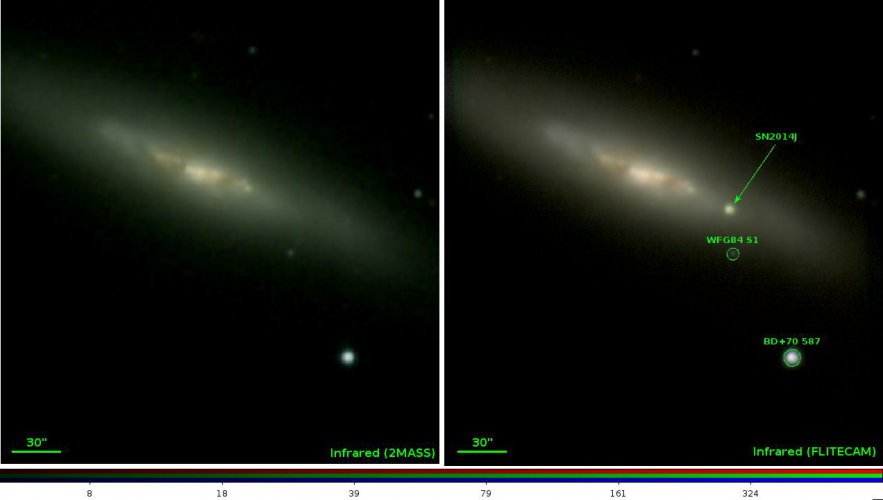
|
|
SOFIA Mid-IR images of Comet ISON
Caption
Images of Comet ISON obtained using SOFIA's FORCAST camera at wavelengths of 11.1, 19.7, and 31.5 microns. Measurements at 31.5 microns, crucial for determining the temperature and other characteristics of the comet's material, cannot be made using ground-based telescopes. In these images, the comet's tail and resulting dust trail points to the upper right of the photo (images smoothed slightly during processing).
Credits
<p>NASA/Jim DeBuizer/Diane Wooden</p>
|
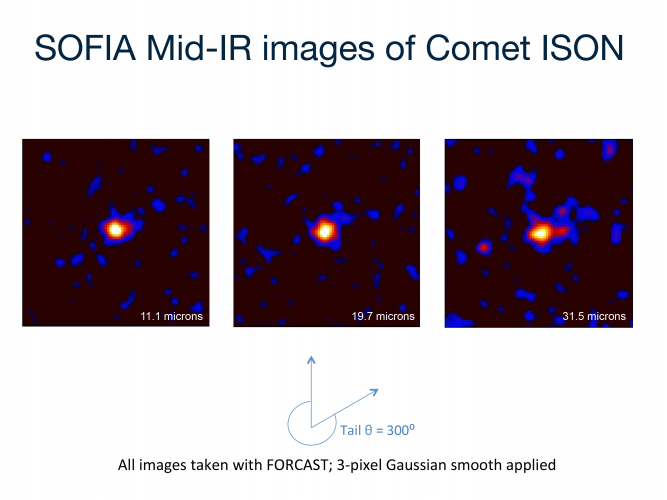
|
|
Milky Way Galaxy Circumnuclear Ring
Caption
Figure 1a: SOFIA/FORCAST mid-infrared image of the Milky Way Galaxy's nucleus showing the Circumnuclear Ring (CNR) of gas and dust clouds orbiting a central supermassive black hole. The bright Y-shaped feature is believed to be material falling from the ring toward the black hole that is located where the arms of the "Y" intersect. Figure 1b: HST/NICMOS near-infrared image showing the same field of view with the same scale and orientation as Figure 1a. At this wavelength, opaque dust in the plane of the Milky Way hides features that are seen in the SOFIA image. In contrast, the stars in the HST image emit mostly visible and near-infrared light and so are not seen in the SOFIA mid-infrared image. Extra opacity due to especially dense concentrations of dust in the CNR produces patches of apparently lower star density in the near-infrared image.
Credits
<p>Figure 1a: NASA/DLR/USRA/DSI/FORCAST Team/Lau et al. 2013; Figure 1b: NASA/HST/STScI/AURA</p>
|
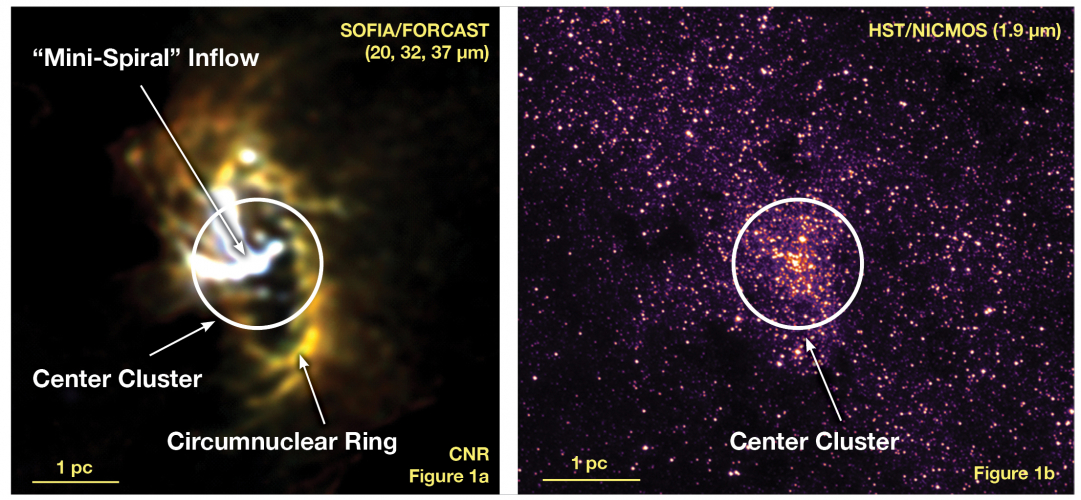
|
|
Quintuplet Cluster (no labels)
Caption
Left: SOFIA/FORCAST mid-infrared image of a region including the Quintuplet Cluster (QC), a group of young stars near the left margin of the frame, located about 35 parsecs (100 light years) from the galaxy's nucleus. The compact bright objects rendered white and blue in this image are dust cloud "cocoons" heated from within by the highest-luminosity stars in the cluster to temperatures that make them prominent at mid-infrared wavelengths. Other features in this image are interstellar clouds of gas and dust. The large rounded oblong feature below the QC is an expanding cloud of debris produced by violent ejections of material from a massive star nearing the end of its life. Right: HST/NICMOS image of the QC region matching the SOFIA/FORCAST field of view in the left figure. The QC itself is at the left of the frame. Most of the features in the SOFIA mid-infrared image are not seen in the HST image due to their low temperatures and intervening interstellar dust.
Credits
<p>Left: NASA/DLR/USRA/DSI/FORCAST Team/Hankins et al. 2013; Right: NASA/HST/STScI/AURA</p>
|
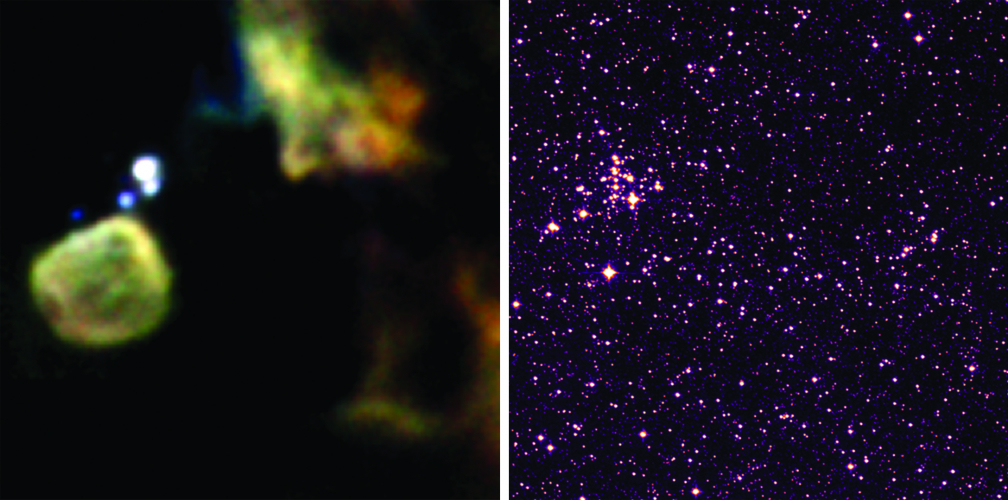
|
|
Quintuplet Cluster
Caption
Figure 2a: SOFIA/FORCAST mid-infrared image of a region including the Quintuplet Cluster (QC), a group of young stars near the left margin of the frame, located about 35 parsecs (100 light years) from the galaxy's nucleus. The compact bright objects rendered white and blue in this image are dust cloud "cocoons" heated from within by the highest-luminosity stars in the cluster to temperatures that make them prominent at mid-infrared wavelengths. Other features in this image are interstellar clouds of gas and dust. The large rounded oblong feature below the QC is an expanding cloud of debris produced by violent ejections of material from a massive star nearing the end of its life. Figure 2b: HST/NICMOS image of the QC region matching the SOFIA/FORCAST field of view in Figure 2a. The QC itself is at the left of the frame. Most of the features in the SOFIA mid-infrared image are not seen in the HST image due to their low temperatures and intervening interstellar dust.
Credits
<p>Figure 2a: NASA/DLR/USRA/DSI/FORCAST Team/Hankins et al. 2013; Figure 2b: NASA/HST/STScI/AURA</p>
|
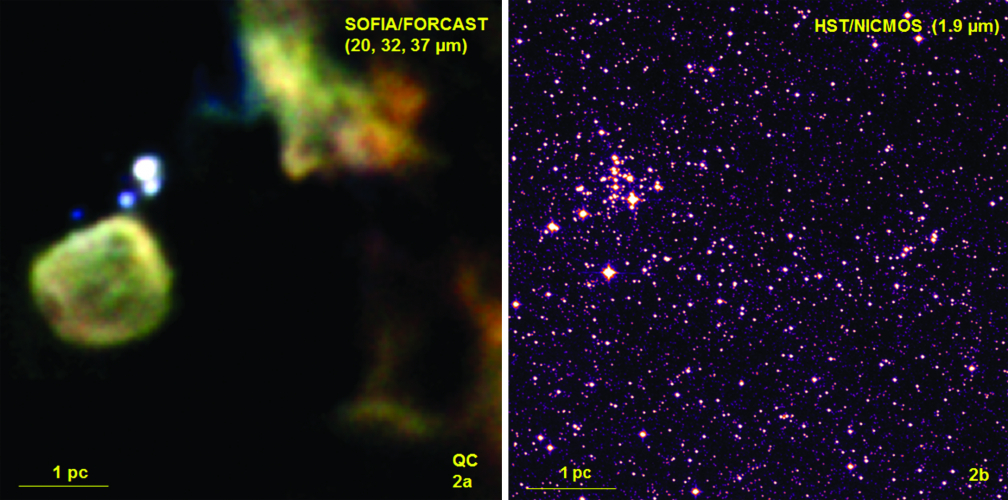
|
|
Quintuplet Cluster
Caption
Figure 2a: SOFIA/FORCAST mid-infrared image of a region including the Quintuplet Cluster (QC), a group of young stars near the left margin of the frame, located about 35 parsecs (100 light years) from the galaxy's nucleus. The compact bright objects rendered white and blue in this image are dust cloud "cocoons" heated from within by the highest-luminosity stars in the cluster to temperatures that make them prominent at mid-infrared wavelengths. Other features in this image are interstellar clouds of gas and dust. The large rounded oblong feature below the QC is an expanding cloud of debris produced by violent ejections of material from a massive star nearing the end of its life. Figure 2b: HST/NICMOS image of the QC region matching the SOFIA/FORCAST field of view in Figure 2a. The QC itself is at the left of the frame. Most of the features in the SOFIA mid-infrared image are not seen in the HST image due to their low temperatures and intervening interstellar dust.
Credits
<p>Figure 2a: NASA/DLR/USRA/DSI/FORCAST Team/Hankins et al. 2013; Figure 2b: NASA/HST/STScI/AURA</p>
|
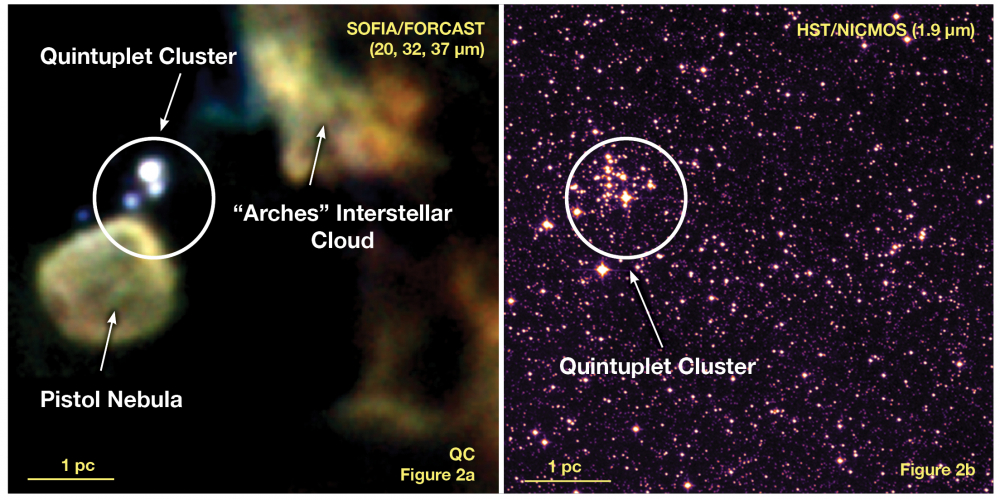
|
|
Milky Way Galaxy Circumnuclear Ring
Caption
Figure 1a: SOFIA/FORCAST mid-infrared image of the Milky Way Galaxy's nucleus showing the Circumnuclear Ring (CNR) of gas and dust clouds orbiting a central supermassive black hole. The bright Y-shaped feature is believed to be material falling from the ring toward the black hole that is located where the arms of the "Y" intersect. Figure 1b: HST/NICMOS near-infrared image showing the same field of view with the same scale and orientation as Figure 1a. At this wavelength, opaque dust in the plane of the Milky Way hides features that are seen in the SOFIA image. In contrast, the stars in the HST image emit mostly visible and near-infrared light and so are not seen in the SOFIA mid-infrared image. Extra opacity due to especially dense concentrations of dust in the CNR produces patches of apparently lower star density in the near-infrared image.
Credits
<p>Figure 1a: NASA/DLR/USRA/DSI/FORCAST Team/Lau et al. 2013; Figure 1b: NASA/ESA/STScI/AURA</p>
|
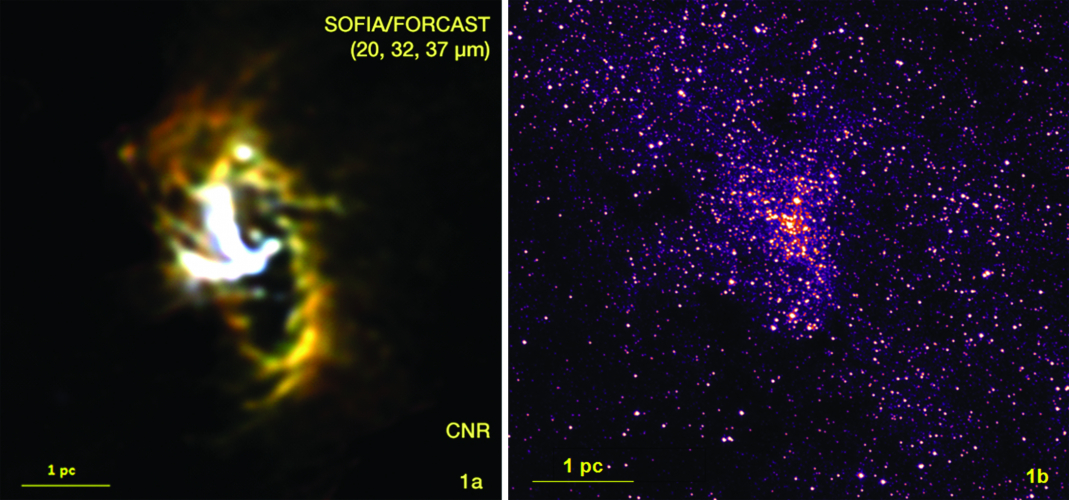
|
|
Milky Way Galaxy Circumnuclear Ring (no labels)
Caption
Left: SOFIA/FORCAST mid-infrared image of the Milky Way Galaxy's nucleus showing the Circumnuclear Ring (CNR) of gas and dust clouds orbiting a central supermassive black hole. The bright Y-shaped feature is believed to be material falling from the ring toward the black hole that is located where the arms of the "Y" intersect. Right: HST/NICMOS near-infrared image showing the same field of view with the same scale and orientation as the left figure. At this wavelength, opaque dust in the plane of the Milky Way hides features that are seen in the SOFIA image. In contrast, the stars in the HST image emit mostly visible and near-infrared light and so are not seen in the SOFIA mid-infrared image. Extra opacity due to especially dense concentrations of dust in the CNR produces patches of apparently lower star density in the near-infrared image.
Credits
<p>Left: NASA/DLR/USRA/DSI/FORCAST Team/Lau et al. 2013; Right: NASA/ESA/STScI/AURA</p>
|

|
|
Planetary Nebula M2-9
Caption
SOFIA images of planetary nebula M2-9 in six different bands (wavelengths indicated on the figures) made using the FORCAST mid-infrared camera (Principal Investigator Terry Herter, Cornell University). The images have been smoothed to emphasize diffuse emission.
Credits
<p>NASA/DLR/USRA/DSI/FORCAST team/M. Werner</p>
|
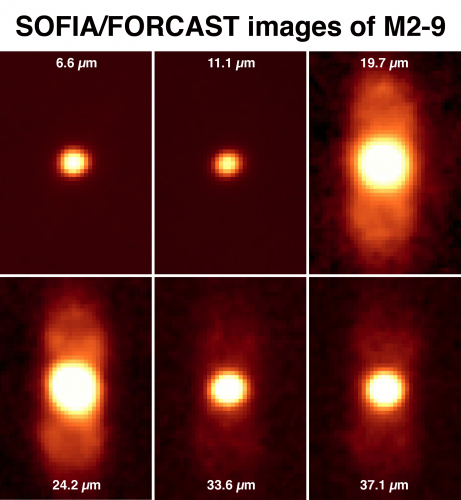
|
|
Planetary Nebula M2-9
Caption
SOFIA mid-infrared image of the planetary nebula Minkowski 2-9 (M2-9), also known as the Butterfly Nebula, compared with a visual-wavelength Hubble Space Telescope image at the same scale and orientation. The nebula is composed of two lobes of gas & dust expelled from a dying star with about the mass of our Sun that is seen at the center of the lobes. The HST image shows mostly ionized gas in the lobes whereas the SOFIA image shows mostly solid grains condensing in the gas. The SOFIA data were obtained during SOFIA's Early Science program in 2011 by a Guest Investigator team led by Michael Werner of Caltech/JPL using the FORCAST camera (P.I.Terry Herter, Cornell University).
Credits
<p>SOFIA image, RGB = 37, 24, 20 microns; NASA/DLR/USRA/DSI/FORCAST team/M. Werner et al./A. Helton, J. Rho; HST image: NASA/ESA/NSF/AURA/Hubble Heritage Team/STScI/B. Balick, V. Icke, G. Mellema</p>
|
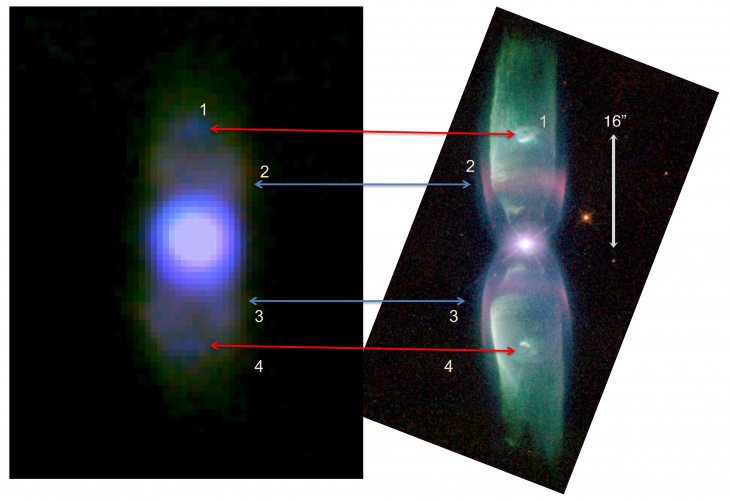
|
|
Planetary Nebula M2-9
Caption
SOFIA mid-infrared image of the planetary nebula Minkowski 2-9 (M2-9), also known as the Butterfly Nebula, compared with a visual-wavelength Hubble Space Telescope image at the same scale and orientation. The nebula is composed of two lobes of gas & dust expelled from a dying star with about the mass of our Sun that is seen at the center of the lobes. The HST image shows mostly ionized gas in the lobes whereas the SOFIA image shows mostly solid grains condensing in the gas. The SOFIA data were obtained during SOFIA's Early Science program in 2011 by a Guest Investigator team led by Michael Werner of Caltech/JPL using the FORCAST camera (P.I.Terry Herter, Cornell University).
Credits
<p>SOFIA image, RGB = 37, 24, 20 microns; NASA/DLR/USRA/DSI/FORCAST team/M. Werner et al./A. Helton, J. Rho; HST image: NASA/ESA/NSF/AURA/Hubble Heritage Team/STScI/B. Balick, V. Icke, G. Mellema</p>
|
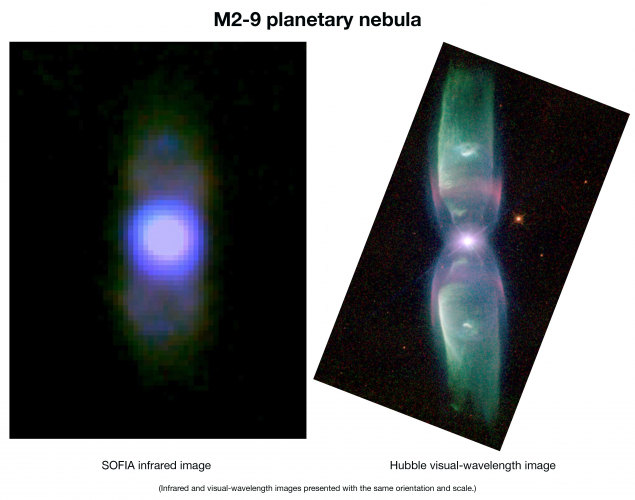
|
|
Planetary Nebula M2-9
Caption
NASA's Stratospheric Observatory for Infrared Astronomy (SOFIA) recently captured this color-composite image of the planetary nebula Minkowski 2-9 (M2-9) showing a dying sun-like star. The observations were made using the Faint Object Infrared Camera for the SOFIA Telescope (FORCAST) instrument, and is composed of images obtained at the mid-infrared wavelengths of 20, 24, and 37 microns, of which 37 microns cannot be seen by ground-based telescopes.
Credits
<p>NASA/DLR/USRA/DSI/FORCAST team/M. Werner et al./A. Helton, J. Rho</p>
|

|
|
Planetary Nebula M2-9
Caption
SOFIA images of planetary nebula M2-9 in six different bands (wavelengths indicated on the figures) made using the FORCAST mid-infrared camera (Principal Investigator Terry Herter, Cornell University). The images have been smoothed to emphasize diffuse emission.
Credits
<p>NASA/DLR/USRA/DSI/FORCAST team/M. Werner</p>
|
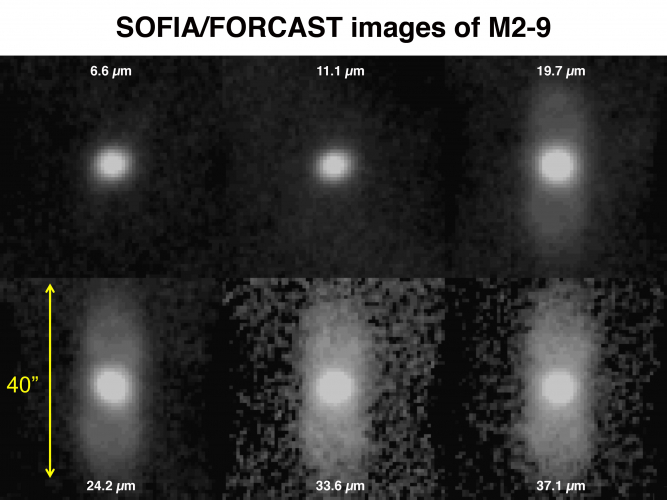
|
|
W3 Star-Forming Complex in Perseus
Caption
Mid-infrared image of the W3 star forming region from SOFIA/FORCAST, inset on a near-infrared image from Spitzer. The SOFIA image dimensions are 150 x 100 arcseconds, corresponding to 5 x 3 light years at a distance of 6400 light years. Arrow indicates a bubble cleared in the nebula by wind and radiation from the most massive newborn star in the cluster.
Credits
<p>SOFIA image, inset: Red, Green, Blue = 37, 20, 7.7 μm; NASA/DLR/USRA/DSI/FORCAST team/F. Salgado, A. Tielens, J. De Buizer. Spitzer image, background: Red, Green, Blue = 7.9, 4.5, 3.6 μm; NASA/Caltech - JPL.</p>
|

|
|
SOFIA Peers into the Heart of the Orion Nebula
Caption
SOFIA/FORCAST mid-infrared images of the M42 star-forming region in Orion shown as insets/overlays on a Spitzer near-infrared image. SOFIA image in blue box: Blue, Green, Red respectively symbolize infrared light with wavelengths of 20, 31, and 37 μm. SOFIA image in red box: B, G, R = 8, 20, and 37 μm. Background Spitzer image: B, G, R = 3.6, 4.5, and 7.9 μm.
Credits
<p>James De Buizer/NASA/DLR/USRA/DSI/FORCAST team; Spitzer image credit: NASA/Caltech-JPL</p>
|
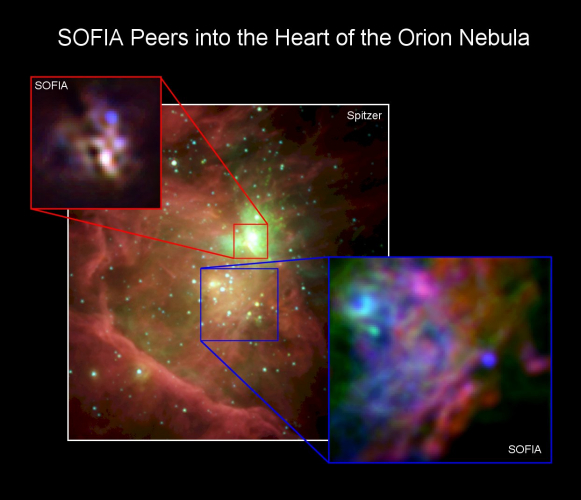
|
|
Comparison of images of the W40 star-forming region made at wavelengths ranging from visible light to far infrared
Caption
Comparison of images of the W40 star-forming region made at wavelengths ranging from visible light to far infrared.
Credits
<p>NASA/DLR/USRA/DSI/Shuping & Vacca/FORCAST team</p>
|
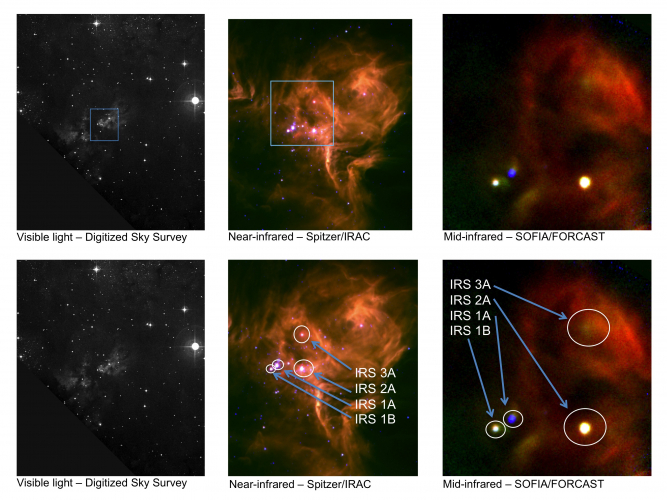
|
|
W40 Star Forming Region
Caption
Mid-infrared image of the W40 star forming region captured with the FORCAST camera. (Blue = 5.4 microns, Green = 24.2 microns, Red = 34.8 microns)
Credits
<p>NASA/DLR/USRA/DSI/R. Shuping & W. Vacca/FORCAST team</p>
|
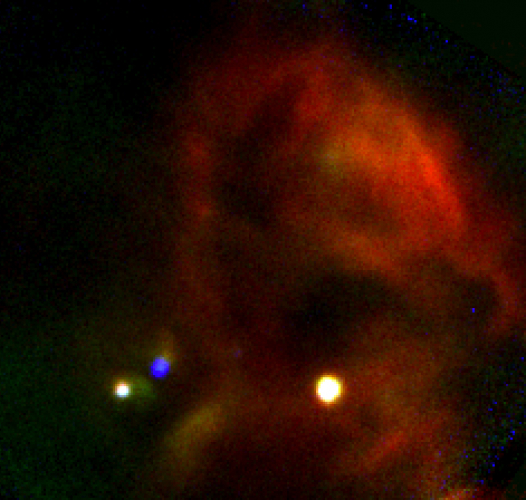
|
|
SOFIA HIPO & FDC observations of a stellar occultation by Pluto
Caption
SOFIA/FDC light curve (black) of June 2011 Pluto stellar occultation compared with model fits (red & green).
Credits
<p>Person <em>et al.</em> 2013, <em>Astrophysical Journal</em> 146, 83.</p>
|
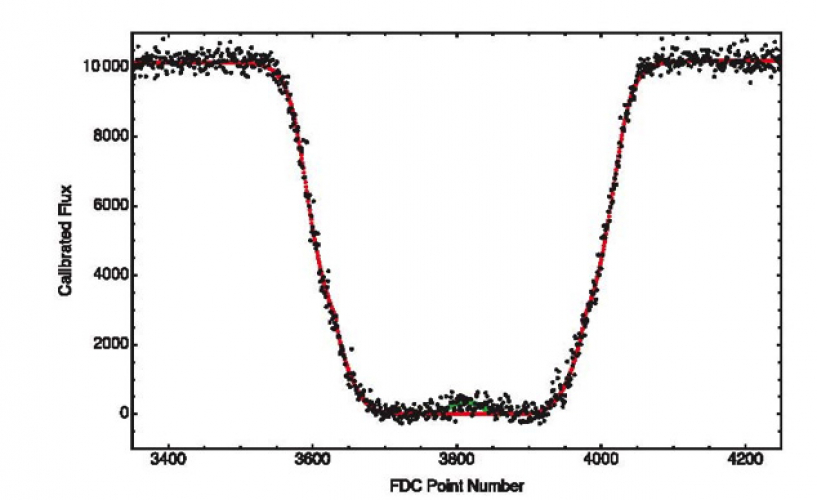
|
|
Orion Triptych, labeled
Caption
Orion Messier 42 region: Three-panel comparison of HST visual-light image, European Southern Observatory near-infrared image, and SOFIA mid-infrared mosaic image.
Credits
Visible-light image: NASA/ESA/HST/AURA/STScI/O'Dell & Wong; Near-IR image: ESO/McCaughrean et al.; Mid-IR image: NASA/DLR/SOFIA/USRA/DSI/FORCAST Team
|

|
|
Far-infrared M17
Caption
High-resolution far-infrared spectra of the nebula Messier 17 (M17) obtained with the GREAT spectrometer and SOFIA on the night of April 5-6, 2011, superimposed on a Spitzer near-infrared image. The white spectra are C II (singly-ionized carbon) and the green spectra are CO (carbon monoxide). The two panels at bottom show maps of C II and CO emission intensity within the red box in the upper panel.
Credits
Spectra and spectral maps: GREAT Team/NASA/DLR/USRA/DSI; Background IR image: NASA/JPL-Caltech/Spitzer
|
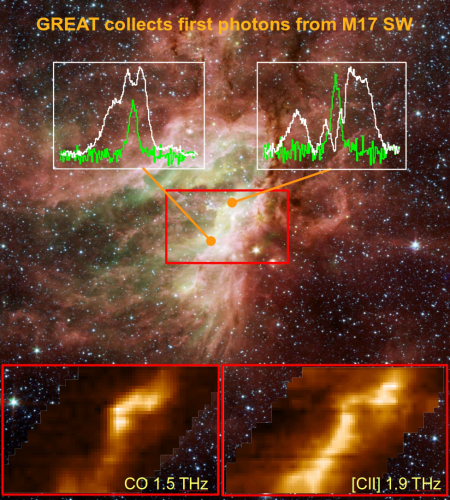
|
|
Orion Triptych
Caption
Orion Messier 42 region: Three-panel comparison of HST visual-light image, European Southern Observatory near-infrared image, and SOFIA mid-infrared mosaic image.
Credits
Visible-light image: NASA/ESA/HST/AURA/STScI/O'Dell & Wong; Near-IR image: ESO/McCaughrean et al.; Mid-IR image: NASA/DLR/SOFIA/USRA/DSI/FORCAST Team
|
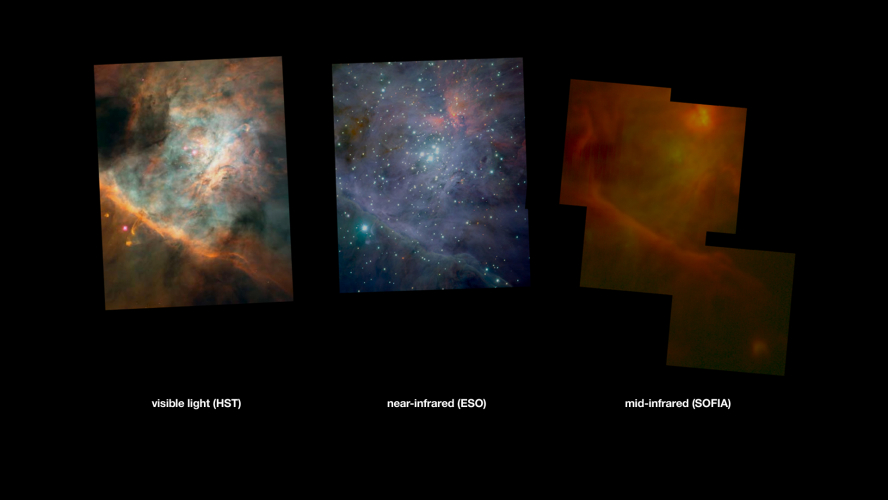
|
|
SOFIA Mid-Infrared Orion
Caption
Orion Messier 42 region: SOFIA mid-infrared (19 and 37 micron) mosaic image.
Credits
NASA/DLR/SOFIA/USRA/DSI/FORCAST Team
|
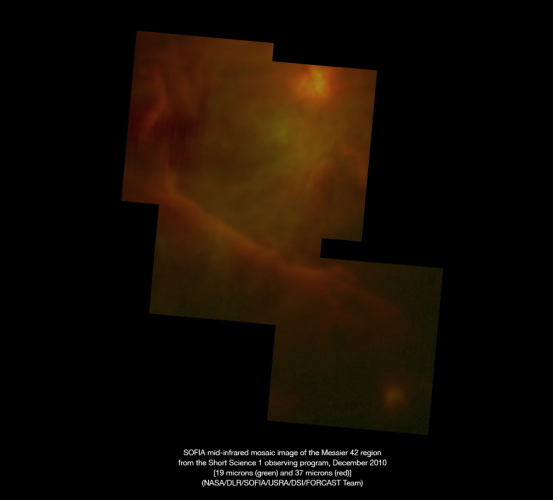
|
|
SOFIA/GREAT Observations of Supernova Remnant W28
Caption
CO emission observed by SOFIA/GREAT (12CO 11-10) and APEX (other lines) from supernova remnant W28.
Credits
<p>A. Gusdorf et al./NASA/DLR/SOFIA/GREAT</p>
|
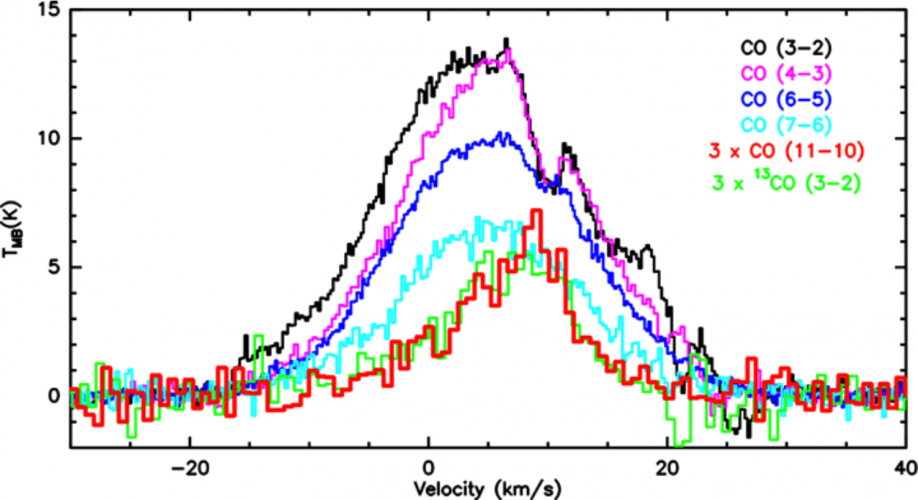
|
|
Infrared Orion
Caption
Infrared image of the heart of the Orion star-formation complex taken from the Stratospheric Observatory for Infrared Astronomy (SOFIA) using the FORCAST mid-infrared camera (P.I. Terry Herter, Cornell University). SOFIA is optimized for observations at infrared wavelengths that cannot be accessed by any telescope on the ground or currently in space. This image, a two-filter composite (20 microns – green, 37 microns – red), reveals detailed structures in the clouds of star forming material, as well as heat radiating from a cluster of luminous newborn stars seen in the upper right. This young stellar cluster was originally identified in 1967 by Eric Becklin and others. Dr. Becklin, SOFIA's Chief Science Advisor, was on the initial science flight that continued the studies of these objects.
Credits
NASA/SOFIA/USRA/FORCAST Team
|
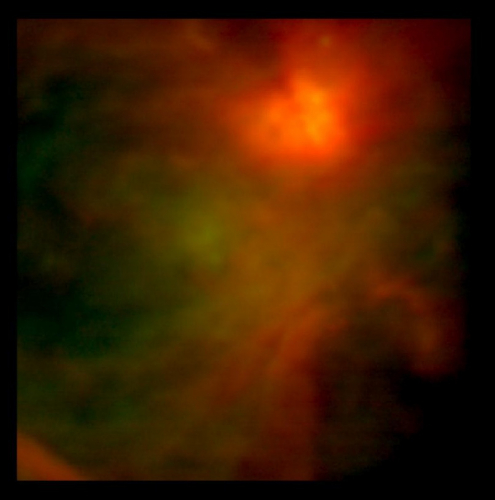
|
|
M82 Composite
Caption
Composite infrared image of the central portion of galaxy M82, from SOFIA’s First Light flight, at wavelengths of 20 (blue), 32 (green) and 37 microns (red). The middle inset image shows the same portion of the galaxy at visual wavelengths. The infrared image views past the stars and dust clouds apparent in the visible-wavelength image into the star-forming heart of the galaxy. The long dimension of the inset boxes is about 5400 light years. Details of the infrared image processing are the same described in the caption for the Jupiter monochromatic images displayed above except that no spatial filter was applied to the M82 image.
Credits
Infrared image: NASA/SOFIA/USRA/FORCAST Team/Bill Vacca; Visual image: N. A. Sharp/ NOAO/AURA/NSF
|
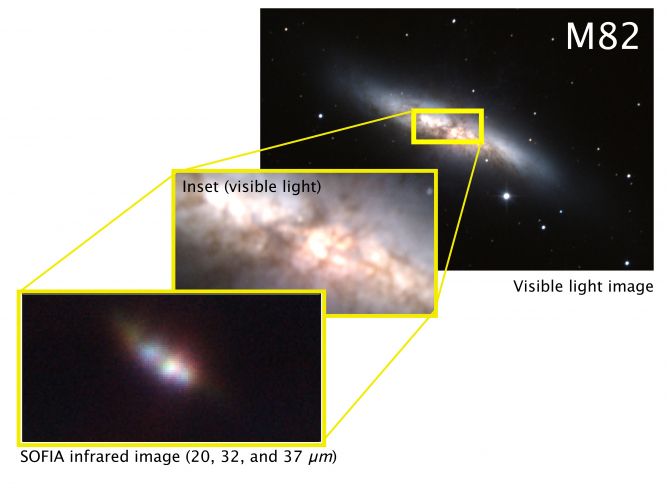
|
|
Jupiter and Three Moons
Caption
SOFIA image of Jupiter and three of the Galilean moons composed of multiple frames taken at wavelengths of 5.4, 24 and 37 microns with the FORCAST infrared camera (P.I. Terry Herter, Cornell University). These data and other measurements from SOFIA’s First Light flight show that the observatory aircraft and telescope were remarkably stable on their first night out. (Image is oriented with Jupiter's north pole at the top.)
Credits
NASA/SOFIA/USRA/FORCAST Team/James De Buizer
|
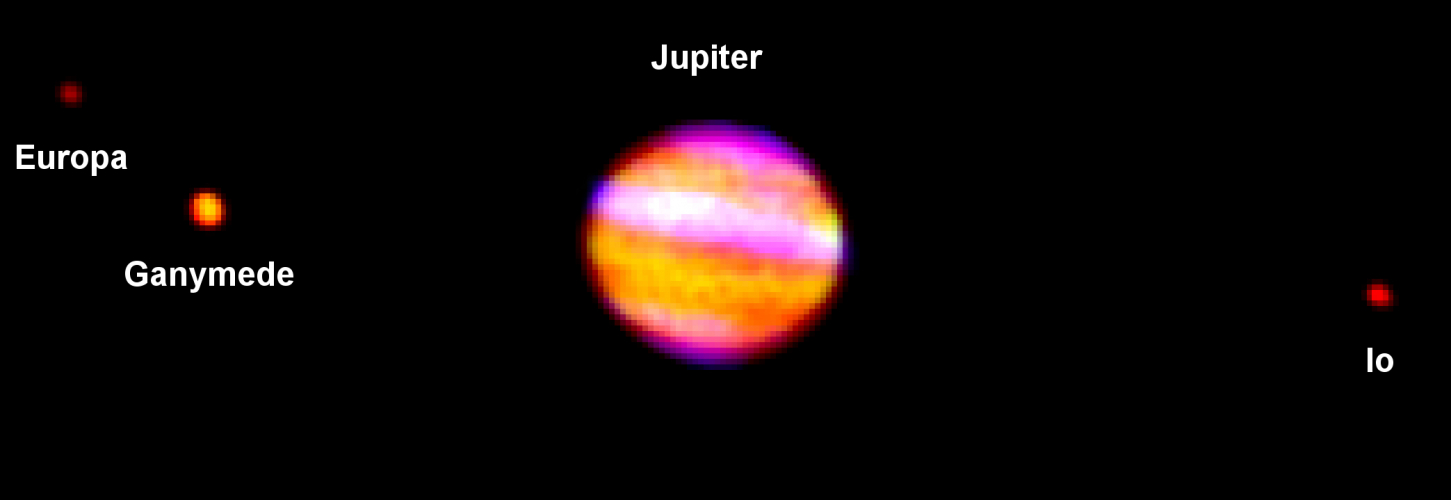
|
|
Jupiter - 3 Broadband Filters
Caption
Jupiter data: FORCAST images were taken in three broadband filters with effective wavelengths of 5.4 µm, 24 µm, and 37 µm. The observing mode made use of the chopping secondary mirror operating with a two-position chop at 10 Hz plus nodding the telescope in an ABBA pattern. Data post-processing included: (1) removal of bad pixels and array pattern (correlated) noise, (2) applying a flat-field correction to remove the effects of pixel-to-pixel responsivity variation, (3) subtracting chop and nod image pairs to remove instrument, telescope and sky background signal, and (4) shifting and summing (coadding) multiple integrations to produce the final images. Each monochromatic image was then processed with a spatial filter to remove effects of telescope jitter and the telescope+camera point spread function. Finally, the three monochromatic images were combined into a red-green-blue color image.
Credits
NASA/SOFIA/USRA/FORCAST Team/James De Buizer
|

|
|
Jupiter in Infrared
Caption
Infrared image of Jupiter from SOFIA’s First Light flight composed of individual images at wavelengths of 5.4 (blue), 24 (green) and 37 microns (red) made by Cornell University’s FORCAST camera. Ground-based infrared observations are impossible at 5.4 and 37 microns and normally very difficult at 24 microns even from high mountaintop observatories such as Mauna Kea due to absorption by water and other molecules in Earth's atmosphere. The white stripe in the infrared image is a region of relatively transparent clouds through which the warm interior of Jupiter can be seen. A recent visual-wavelength picture of approximately the same side of Jupiter is shown for comparison. (Images are oriented with Jupiter's south pole at the top.)
Credits
NASA/SOFIA/USRA/FORCAST Team/James De Buizer (infrared image), Anthony Wesley (visible light image)
|

|